LP75
| Group: Tragowel | Mapped Soil Type: Mysia Loam. |
| General Landscape Description: Slight rise within an irrigated pasture on a flat plain. Original vegetation included Grey Box (Eucalyptus microcarpa) and Buloke (Allocasuarina luehmannii). | |
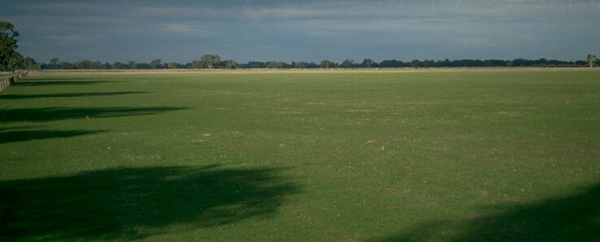 LP75 Landscape |
Soil Profile Morphology
Surface Soil
| A11 | 0-10 cm | Reddish brown (5YR4/3); fine sandy clay loam; hardsetting surface condition; weak coarse blocky structure with a plough line evident; firm consistence moist; pH 5.9; abrupt and smooth change to: | 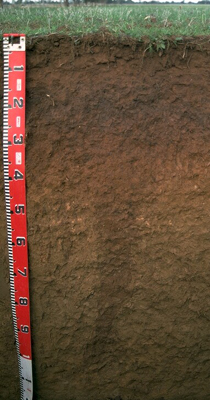 LP75 Profile |
| A12 | 10-20 cm | Dark brown (7.5YR3/4); fine sandy clay loam; weak medium blocky structure; very firm consistence dry; pH 6.0; abrupt and wavy change to: | |
| Subsoil | |||
| B21 | 20-35 cm | Reddish brown (5YR4/4); light medium clay (subplastic); moderate medium blocky structure; weak consistence moist; pH 7.9; clear change to: | |
| B22 | 35-70 cm | Strong brown (7.5YR5/6); medium clay; strong fine polyhedral structure; weak consistence moist; contains a few (5-10%) hard and semi-hard carbonate and silica nodules (5-15 mm in size); pH 8.9; gradual change to: | |
| B23 | 70-105 cm | Strong brown (7.5YR5/6); light medium clay; moderate medium polyhedral structure; weak consistence moist; contains a few (2-5%) carbonate and silica tubes (5-20 mm in size); pH 9.0; gradual change to: | |
| B24 | 105+ cm | Strong brown (7.5YR5/6); sandy clay with clay tubules (up to 1 cm in size); weak structure; weak consistence moist; pH 9.0. | |
Key Profile Features
- Hardsetting and sandy (60%) surface soil.
- Strong texture contrast between surface (A) horizon (14% clay) and sodic subsoil (B21) horizon (45% clay).
- Accumulation of hard carbonate and silica nodules throughout the subsoil.
Soil Profile Characteristics
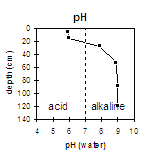 | 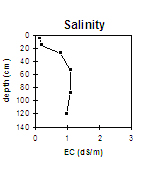 | 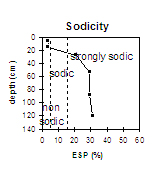 | 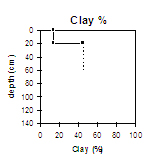 |
The surface soil is moderately acid. The subsoil is slightly alkaline becoming strongly alkaline at about 40cm. | The salinity rating is low becoming medium to high in the subsoil. | The surface is non-sodic. The subsoil is strongly sodic throughout. | There is an abrupt increase in clay at 20 cm. |
Surface (A) Horizon
- The surface soil is hardsetting and has a very high fine sand content (58%). When cultivated in a dry condition it will become ‘powdery’ and subsequent rainfall may result in surface sealing occurring. Soils such as these rely to a large extent on organic matter for maintaining aggregation. The levels of organic carbon measured at the pit site (which may or may not be representative of the whole paddock) is low. Organic matter levels will build up under pasture but will decline if cropping takes place. Practices such as residue retention, minimum tillage and including pasture rotations could be utilised if cropping takes place in order to build up organic matter, improve aggregation as well as assist in the low water holding capacity and reduce erosion risk.
- Infiltration of water is likely to be high in the surface soils. However, the clay content increases significantly at the subsoil and water is likely to sit on top of the more slowly permeable subsoil.
- The inherent fertility is low and planting legumes may help to increase nutrients within the surface layers.
- The levels of total nitrogen measured at this pit site is low. However, this is best assessed by taking a bulked sample from across the paddock.
- The surface soil is non-sodic with no dispersion. The presence of moderate dispersion after remoulding indicates that structural degradation (e.g. surface sealing, increased cloddiness) may occur if the soil is cultivated or overstocked in a moist to wet condition. Also, raindrop action on bare surface soil may also promote dispersion and exacerbate the hardsetting condition. Surface cover should be maintained to protect against raindrop damage. The use of gypsum may assist in ameliorating the surface soil and decreasing the hardsetting condition. Interestingly, a plough line was observed within this horizon.
- The low wilting point value (5.5) of the surface horizon indicates that plants will be able to utilise very light rains when the soil is dry. However, due to the low water storage capacity, plants will soon suffer moisture stress unless further rain falls occur.
Subsoil (B) Horizons
- The subsoil is strongly sodic with a low exchangeable calcium to magnesium ratio (0.6) and moderate dispersion (complete dispersion after remoulding). This indicates that root and water movement will be significantly restricted. Deep ripping into the subsoil would help to break up the physical structural problems and the application of gypsum would help to neutralise the chemical sodic problems. This expensive option would firstly depend on expected crop yield and also on adequate rainfall, to wash the gypsum down the deep rips into the subsoil. Gypsum can also be added to the surface without deep ripping, but it would require more time to wash the gypsum down to the subsoil and less of it would probably make it.
- The subsoil becomes strongly alkaline at 45 cm. This suggests that some nutrients (e.g. iron, manganese, zinc, copper) may be poorly available to plants and that deficiencies are likely to occur. Deficiencies can be determined by plant tissue analysis.
- The subsoil becomes highly saline at about 50 cm and is likely to restrict the growth of salt sensitive plant species (e.g. faba beans, linseed, chickpeas and lupins).
- The subsoil has a moderate inherent fertility throughout which is quite beneficial to plant growth.
Comments:
- The site was irrigated in 1956.
- The landholder stated that the soil produces a good crop if it is not over cropped. The rotation used includes three years of pasture then a wheat crop and the average harvest is 14 bags.
Notes:
Profile described by Mark Imhof, Sonia Thompson and Paul Rampant, May 1995.


